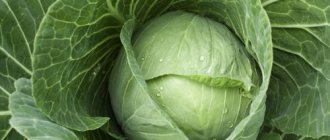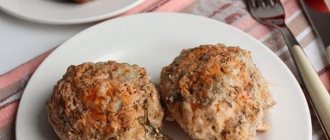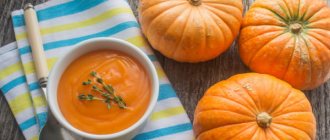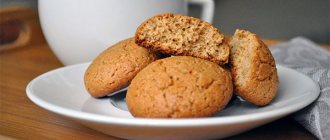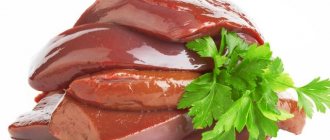Cabbage soup for weight loss is the basis of a popular “fast” diet. However, you can cook and eat it as a regular first course; it will not lose its beneficial properties. There are many recipes for this soup. They are united by low calorie content, relative ease of preparation, and the use of only fresh, high-quality vegetables. Remember that nutritionists are not very positive about the idea of “sitting on soup for a week.” Still, the first cabbage contains too few calories, protein, fats and carbohydrates to be considered a complete meal. However, there are other options besides a cleansing diet.
Diet food
To get rid of extra pounds, you need to reduce the energy volume of food consumed per day, and increase physical activity (energy expenditure). Only a lack of energy forces the body to “burn” fat.
The unit for calculating the energy value of food - kilocalorie (kcal) - allows you to determine which food is dietary and which is not. The higher the calorie content of a product or dish, the worse it is.
Soups can and should even be included in diets, since hot first courses with plenty of liquid relieve hunger for a long time.
In order for them to help melt excess weight, you need to:
- cook in water or low-fat (chicken, beef) broth with minimal use of oil;
- use low-calorie vegetables and herbs as ingredients.
Diet cabbage soup is a great example of a daily meal for weight loss. But the weight loss course on this dish is short-term. For a short period of time (up to a maximum of 10 days), dietary cabbage soup becomes the main and main dish of the day. Low-calorie foods are added to it: fruits, vegetables, boiled chicken, brown rice.
For example, the daily diet looks like this - cabbage soup (without restrictions) plus one of the sets of products (calorie content is indicated per 100g):
- Fruits with a calorie content of up to 60 kcal (bananas and dried fruits are not allowed).
- Vegetable salad (vegetables with a calorie content of up to 50-60 kcal, for example, cabbage, carrots, onions, beets, celery, ground peppers, herbs, etc.) with vegetable oil dressing.
- Boiled brown rice with steamed or fresh vegetables.
- Boiled skinless chicken breast with vegetables, etc.
Important! Cabbage soup is included in any diet that allows vegetables. It will perfectly complement the carbohydrate, vegetable, Brazilian diet. For those who do not adhere to a ready-made food plan, but themselves count the calorie content of their dishes, it will also come in very handy.
Recipes with photos
On a cabbage diet, soup can be cooked in large quantities at once; the dish will not stay in the refrigerator for a long time. The recipes are for a 5-6 liter pan.
Important! Before cooking, vegetables and herbs are thoroughly washed and cleaned. Salt, pepper, and other spices are added according to personal preference.
Classical
You will need the following set of products:
- white cabbage – 1.5-2 kg;
- celery stalks – 350-400 g (5-6 stalks);
- turnip onion – 400 g;
- tomatoes – 500 g;
- carrots – 400 g (5-6 medium-sized pieces);
- bell pepper – 200 g (2-3 pcs.).
Use greens at your discretion. Usually, a few green onions and a bunch of parsley and dill are enough.
The process of preparing cabbage soup for weight loss is very simple:
- Chop vegetables, greens, add water in a saucepan.
- 5-7 minutes after the start of boiling, reduce the heat to low.
- The dish is ready when the vegetables are soft.
Peculiarity! Fresh tomatoes can be replaced with canned ones (of the same volume). And add a spoonful of tomato paste to the soup.
Borsch
The recipe uses red cabbage, but if desired, you can use regular white cabbage.
Ingredients for borscht:
- red cabbage – 1.5-2 kg;
- beets – 200 g (2 pcs.);
- carrots – 200 g (2 pcs.);
- onion - 3 medium onions;
- garlic – 2-3 cloves;
- tomato paste;
- vinegar or lemon juice.
Cooking process:
- First of all, you need to cook the beets. It is grated on a coarse grater along with carrots, placed in a frying pan, and simmered with a little water and 1-2 tablespoons of tomato paste.
- Chop all other soup ingredients, add water in a saucepan, and cook until half cooked.
- Add beets with carrots, finely chopped herbs, bay leaves, squeeze out the garlic with a garlic press.
- After 5 minutes, turn off the stove.
- Dietary borscht is infused for 1-2 hours, then it turns out especially tasty.
Important! To make the borscht a rich “beetroot” color, pour lemon juice over the beets and carrots when stewing. An option is to use water with a small amount of vinegar added (a couple of drops in half a glass of water, until moderately acidic). Then the beets will not lose their thick shade.
Assorted
Brussels sprouts and cauliflower differ in taste from white and red cabbage. But these varieties have all the beneficial properties of their family.
For a large pot of Brussels sprouts and cauliflower soup you will need:
- Brussels sprouts – 20-25 pcs.;
- cauliflower – 1-1.5 kg;
- ground pepper – 200 g;
- tomatoes – 200 g;
- carrots – 100 g;
- ghee - 2 tbsp.
Cooking process:
- Chopped tomatoes and carrots are first stewed in melted butter (it is better to chop the carrots on a grater) with the addition of water. You can add green onions to the mixture.
- Place Brussels sprouts and cauliflower into the pan (separate them into inflorescences). Add water, cook for 10 minutes.
- Then add the chopped bell peppers to the pan and cook for another 5 minutes.
- Add tomato-carrot dressing.
- After 5 minutes, turn off the stove and leave the soup to steep for at least an hour.
You can add celery (2-3 stalks) to the ingredients. It is finely chopped and loaded into a pan along with sweet pepper. The finished soup is sprinkled with fresh or dry dill.
Interesting!
Cabbage soup recipe. Calorie, chemical composition and nutritional value.
Nutritional value and chemical composition of Cabbage Soup.
The table shows the nutritional content (calories, proteins, fats, carbohydrates, vitamins and minerals) per 100 grams of edible portion.
| Nutrient | Quantity | Norm** | % of the norm in 100 g | % of the norm in 100 kcal | 100% normal |
| Calorie content | 36.5 kcal | 1684 kcal | 2.2% | 6% | 4614 g |
| Squirrels | 1.8 g | 76 g | 2.4% | 6.6% | 4222 g |
| Fats | 0.2 g | 56 g | 0.4% | 1.1% | 28000 g |
| Carbohydrates | 6.8 g | 219 g | 3.1% | 8.5% | 3221 g |
| Organic acids | 0.2 g | ~ | |||
| Alimentary fiber | 2.1 g | 20 g | 10.5% | 28.8% | 952 g |
| Water | 88 g | 2273 g | 3.9% | 10.7% | 2583 g |
| Ash | 0.821 g | ~ | |||
| Vitamins | |||||
| Vitamin A, RE | 128.1 mcg | 900 mcg | 14.2% | 38.9% | 703 g |
| alpha carotene | 0.102 mcg | ~ | |||
| beta carotene | 0.793 mg | 5 mg | 15.9% | 43.6% | 631 g |
| beta Cryptoxanthin | 0.113 mcg | ~ | |||
| Lutein + Zeaxanthin | 2.006 mcg | ~ | |||
| Vitamin B1, thiamine | 0.051 mg | 1.5 mg | 3.4% | 9.3% | 2941 g |
| Vitamin B2, riboflavin | 0.062 mg | 1.8 mg | 3.4% | 9.3% | 2903 g |
| Vitamin B4, choline | 11.36 mg | 500 mg | 2.3% | 6.3% | 4401 g |
| Vitamin B5, pantothenic | 0.128 mg | 5 mg | 2.6% | 7.1% | 3906 g |
| Vitamin B6, pyridoxine | 0.15 mg | 2 mg | 7.5% | 20.5% | 1333 g |
| Vitamin B9, folates | 17.057 mcg | 400 mcg | 4.3% | 11.8% | 2345 g |
| Vitamin C, ascorbic acid | 52.04 mg | 90 mg | 57.8% | 158.4% | 173 g |
| Vitamin E, alpha tocopherol, TE | 0.17 mg | 15 mg | 1.1% | 3% | 8824 g |
| Vitamin H, biotin | 0.302 mcg | 50 mcg | 0.6% | 1.6% | 16556 g |
| Vitamin K, phylloquinone | 43.4 mcg | 120 mcg | 36.2% | 99.2% | 276 g |
| Vitamin RR, NE | 0.9377 mg | 20 mg | 4.7% | 12.9% | 2133 g |
| Niacin | 0.683 mg | ~ | |||
| Macronutrients | |||||
| Potassium, K | 283.88 mg | 2500 mg | 11.4% | 31.2% | 881 g |
| Calcium, Ca | 37.57 mg | 1000 mg | 3.8% | 10.4% | 2662 g |
| Silicon, Si | 38.074 mg | 30 mg | 126.9% | 347.7% | 79 g |
| Magnesium, Mg | 17.24 mg | 400 mg | 4.3% | 11.8% | 2320 g |
| Sodium, Na | 10.24 mg | 1300 mg | 0.8% | 2.2% | 12695 g |
| Sera, S | 52.48 mg | 1000 mg | 5.2% | 14.2% | 1905 |
| Phosphorus, P | 41.1 mg | 800 mg | 5.1% | 14% | 1946 |
| Chlorine, Cl | 35.15 mg | 2300 mg | 1.5% | 4.1% | 6543 g |
| Microelements | |||||
| Aluminium, Al | 522.1 mcg | ~ | |||
| Bor, B | 197.8 mcg | ~ | |||
| Vanadium, V | 19.7 mcg | ~ | |||
| Iron, Fe | 0.723 mg | 18 mg | 4% | 11% | 2490 g |
| Yod, I | 3.33 mcg | 150 mcg | 2.2% | 6% | 4505 g |
| Cobalt, Co | 3.406 mcg | 10 mcg | 34.1% | 93.4% | 294 g |
| Lithium, Li | 11.556 mcg | ~ | |||
| Manganese, Mn | 0.1864 mg | 2 mg | 9.3% | 25.5% | 1073 g |
| Copper, Cu | 83.34 mcg | 1000 mcg | 8.3% | 22.7% | 1200 g |
| Molybdenum, Mo | 8.096 mcg | 70 mcg | 11.6% | 31.8% | 865 g |
| Nickel, Ni | 10.344 mcg | ~ | |||
| Rubidium, Rb | 144.7 mcg | ~ | |||
| Selenium, Se | 0.417 mcg | 55 mcg | 0.8% | 2.2% | 13189 g |
| Strontium, Sr | 1.37 mcg | ~ | |||
| Fluorine, F | 17.97 mcg | 4000 mcg | 0.4% | 1.1% | 22259 g |
| Chromium, Cr | 4.8 mcg | 50 mcg | 9.6% | 26.3% | 1042 g |
| Zinc, Zn | 0.4853 mg | 12 mg | 4% | 11% | 2473 g |
| Zirconium, Zr | 0.29 mcg | ~ | |||
| Digestible carbohydrates | |||||
| Starch and dextrins | 1.695 g | ~ | |||
| Mono- and disaccharides (sugars) | 5.1 g | max 100 g | |||
| Glucose (dextrose) | 1.962 g | ~ | |||
| Sucrose | 1.804 g | ~ | |||
| Fructose | 1.281 g | ~ | |||
| Essential amino acids | 0.357 g | ~ | |||
| Arginine* | 0.091 g | ~ | |||
| Valin | 0.053 g | ~ | |||
| Histidine* | 0.022 g | ~ | |||
| Isoleucine | 0.048 g | ~ | |||
| Leucine | 0.062 g | ~ | |||
| Lysine | 0.063 g | ~ | |||
| Methionine | 0.017 g | ~ | |||
| Methionine + Cysteine | 0.032 g | ~ | |||
| Threonine | 0.046 g | ~ | |||
| Tryptophan | 0.013 g | ~ | |||
| Phenylalanine | 0.052 g | ~ | |||
| Phenylalanine+Tyrosine | 0.098 g | ~ | |||
| Nonessential amino acids | 0.748 g | ~ | |||
| Alanin | 0.062 g | ~ | |||
| Aspartic acid | 0.14 g | ~ | |||
| Glycine | 0.045 g | ~ | |||
| Glutamic acid | 0.232 g | ~ | |||
| Proline | 0.049 g | ~ | |||
| Serin | 0.052 g | ~ | |||
| Tyrosine | 0.044 g | ~ | |||
| Cysteine | 0.017 g | ~ | |||
| Sterols (sterols) | |||||
| beta sitosterol | 1.191 mg | ~ | |||
| Saturated fatty acids | |||||
| 16:0 Palmitinaya | 0.007 g | ~ | |||
| 18:0 Stearic | 0.001 g | ~ | |||
| Monounsaturated fatty acids | 0.016 g | min 16.8 g | 0.1% | 0.3% | |
| 18:1 Oleic (omega-9) | 0.015 g | ~ | |||
| Polyunsaturated fatty acids | 0.008 g | from 11.2 to 20.6 g | 0.1% | 0.3% | |
| 18:2 Linolevaya | 0.008 g | ~ | |||
| 18:3 Linolenic | 0.008 g | ~ | |||
| Omega-3 fatty acids | 0.1 g | from 0.9 to 3.7 g | 11.1% | 30.4% |
The energy value of cabbage soup is 36.5 kcal.
Primary Source: Created in the application by the user. Read more.
** This table shows the average levels of vitamins and minerals for an adult. If you want to know the norms taking into account your gender, age and other factors, then use the “My Healthy Diet” application.
Reviews and results
If you strictly adhere to the cabbage soup diet, not allowing yourself “forbidden” foods, your weight loss will be 2-5 kg in a week. The difference in results depends on individual metabolism, initial weight, and level of physical activity of the person.
Olga: “Today is the last day of the 7-day cabbage soup diet. It took about 3 kg, in principle, this is not bad for me. The main thing is that I didn’t starve on a diet, since soup can be eaten in any quantity.”
Tatyana: “The weight started to come off only on the 4th day, but over the last three days I lost 2.5 kg at once. I’ll tell you a secret: I pureed all the soup in a blender, so it turns out much tastier and doesn’t become so boring! I also added suneli hops to it, I recommend it.”
Anna: “I “sat” on cabbage soup twice. On my first try, I lost 5 kg in 8 days. Probably because I ate it without salt at all. I added a lot of tomato paste to the soup, it has few calories, and it improves the taste. The second time I salted the soup, lasted 5 days, lost 2 kg. I think it’s not bad!”
Peculiarity! People who have lost excess weight on diet cabbage soup note that they still need to limit themselves in nutrition. If you return to excessive consumption of sweets, fatty and starchy foods, the lost kilograms will quickly return to their place.
Subtleties of cooking
Keen cooks will be interested in learning all the nuances of preparing delicious first courses with cabbage:
- To prepare the soup, you can use some fresh cabbage and some sauerkraut. Especially if you like a sour taste. But this option will be quite salty.
- Many nutritionists advise reducing the amount of salt in your diet to help the body get rid of excess fluid. To prevent soup without salt from being bland, use spices and herbs.
- The taste of a dish can be improved without adding calories. For example, add more tomato paste. Or use lemon, apple cider vinegar.
Dietary cabbage soups are easy to prepare on the stove, in the oven or in the slow cooker.
How to cook cabbage soup for weight loss?
To do this, prepare:
- white cabbage - 0.4 kg;
- 5 onions;
- a little dill;
- celery - 0.2 kg;
- 1 bunch of parsley;
- 1 medium carrot;
- sweet pepper - 0.2 kg;
- aromatic spices;
- tomatoes - 0.3 kg.
Cabbage soup for weight loss: recipe step by step
- Wash all vegetables thoroughly and peel them. To remove the skin from the tomatoes, place them in boiling water for a couple of seconds.
- Remove the top leaves from the cabbage and chop it.
- Dice the pepper, onion, celery and carrot.
- Grate the tomatoes or chop them finely.
- Pour water into a container, bring to a boil and add chopped vegetables and onions. Add spices, chopped parsley and dill. Let it sit on the stove for at least fifteen minutes.
Before serving, garnish the soup with chopped herbs.
You can add a little chicken fillet to diet cabbage soup for weight loss. A portion of protein will not only do no harm, but will also bring tangible benefits.
Protein products prevent the appearance of sagging skin, maintain muscle tone and condition, and fill you up better and longer than any vegetables.
conclusions
When choosing a cabbage soup diet, it is important to remember: it is designed for a short period. Nutritionists recommend: normalize weight loss within 4-5 kg per month. In this mode, minimal harm is caused to the body. A quick loss of 3-5 kg in one week is, of course, attractive, but harmful to health. It is optimal to include dietary cabbage soup and borscht in your diet in order to lose weight “tastefully”, but not in a hurry.
How to spend more time on yourself and your family, rather than spending hours cooking? How to make a dish beautiful and appetizing? How to get by with a minimum number of kitchen appliances? The 3in1 miracle knife is a convenient and functional kitchen assistant. Try it with a discount.
How to use cabbage soup for weight loss
The well-known cabbage soup diet “advises” eating it for breakfast, lunch and dinner. We will try to create a healthy, balanced diet with soup, based on the principles of fractional nutrition, and a menu recommended by nutritionists at the Palette Nutrition clinic.
Diet with soup for 1200 kcal
- Breakfast: 200 g oatmeal with water, 100 g cottage cheese, cinnamon, half a baked apple, 350 kcal.
- Snack: large pear, 100 ml 1.5% fat yogurt without sugar, 150 kcal.
- Lunch: cabbage soup with a tablespoon of yogurt, chicken breast, 200 gr. 300 kcal.
- Snack: large vegetable salad with vegetable oil and crispbread, 200 kcal.
- Dinner: a bowl of soup and 150 g of boiled beans, or a portion of fish with vegetables, or 1 glass of kefir with bran and an orange.
To add calories to this basic menu if you're working out, add a carbohydrate side dish like buckwheat or brown rice to your lunch and some protein, like a piece of chicken or beef, to your snack.



